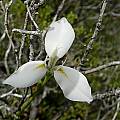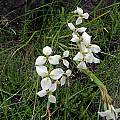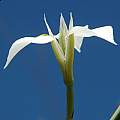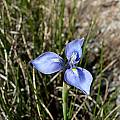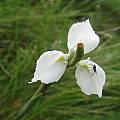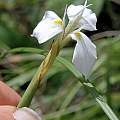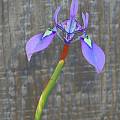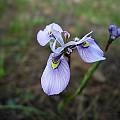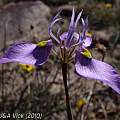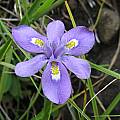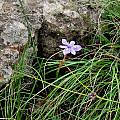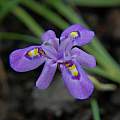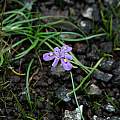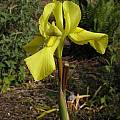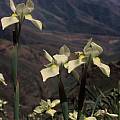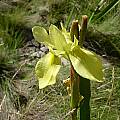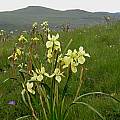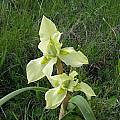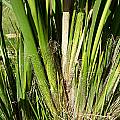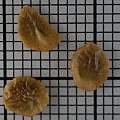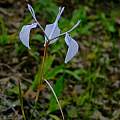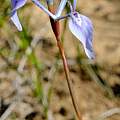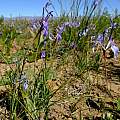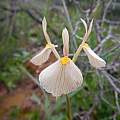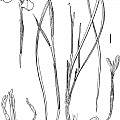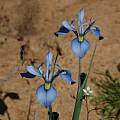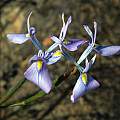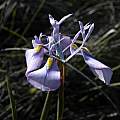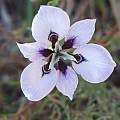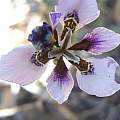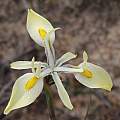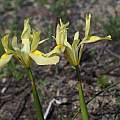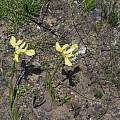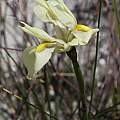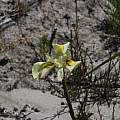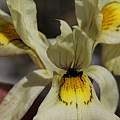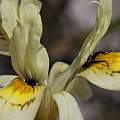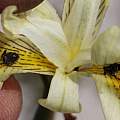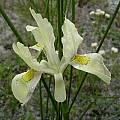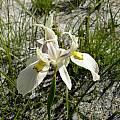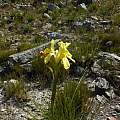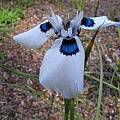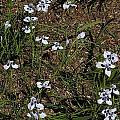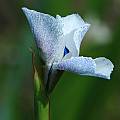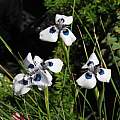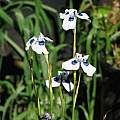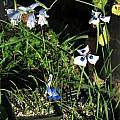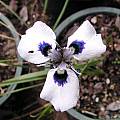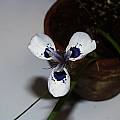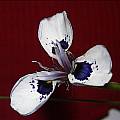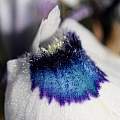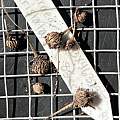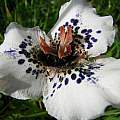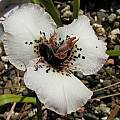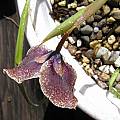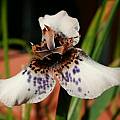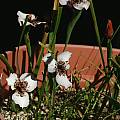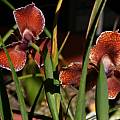The genus Moraea can be divided into five groups: Galaxia, Gynandriris, Hexaglottis, Homeria, and Moraea.
Moraea group species a are found on this wiki page. More information can be learned from Peter Goldblatt's book on Moraeas.
Moraea index lists all the species in all five groups alphabetically.
The other species in the Moraea group are listed alphabetically on these wiki pages: Moraea group b - Moraea group c-e - Moraea group f - Moraea group g-i - Moraea group j-m - Moraea group n-r - Moraea group s - Moraea group t - Moraea group u-v
Moraea albicuspa Goldblatt occurs in well watered mountain grassland in the southern Drakensberg mountains KwaZulu-Natal where it is usually found among rocks or in thick clumps. It has large cream to white flowers with reduced inner needle-like tepals. Photos 1-2, 4 taken by Cameron McMaster in the Eastern Cape. The first three were taken at Naude's Nek Pass in the Drakensberg and the fourth at Tiffendell. This area is high altitude grassland. The last two were taken at Maclear. The third one was taken by Mary Sue Ittner and the last one is from Bob Rutemoeller.
Moraea algoensis Goldblatt is found in the Cape on clay slopes in renosterveld where it blooms in late winter, early spring. Rarely less than 30 cm, it has one long leaf and small violet flowers with white to yellow nectar guides that stay open for several days. It resembles Moraea tripetala but is much smaller. The first photo by Mary Sue Ittner of a plant in cultivation and the second from Cameron McMaster of a plant photographed in the Eastern Cape. The last photo from the book Plants of the Klein Karoo courtesy of Jan and Anne Lise Schutte-Vlok.
Moraea alpina Goldblatt grows in the high altitude areas of KwaZulu-Natal, Lesotho and Transkei in open rocky sites or low mountain grassland. It has dark blue to violet flowers with yellow-orange nectar guides. Photos taken by Cameron McMaster at Sentinel Peak and Mary Sue Ittner at Naude's Nek in the Drakensberg Mountains.
Moraea alticola Goldblatt is a plant from the higher parts of the Drakensberg Mountains in South Africa KwaZulu-Natal and also is found in Lesotho. It is a largest, most robust plant in the genus with one solitary leaf and pale-yellow flowers with darker-yellow nectar guides. It is the largest, most robust species in the genus and is also distinctive in the inner cataphyll with forms an extensive pale network around the base of the stem and leaf. The first picture from Bob Rutemoeller shows this species planted in a raised bed and blooming in Harry Hay's gardens in May 2004. The next photos were taken by Rod Saunders and Cameron McMaster in habitat. The last four pictures were taken at Naude's Nek Pass (high altitude grassland). The last one shows the pale network around the stem and leaf.
Seed on a 1 mm grid, photo by David Pilling.
Moraea amabilis Diels is part of the Moraea tripetela complex. Information about it has been taken from the Goldblatt, Manning article describing the complex. It is found in light clay soils or in sandy loam from the Olifants River Valley to the Bokkeveld Escarpment and in an arc across the northern edge of the Roggeveld Escarpment and south through the Roggeveld and Klein Roggeveld to Worcester and the western end of the Little Karoo. Growing from 15-25 cm, it has a single solitary channeled leaf and purple or dark blue flowers, but occasionally pink, yellow, or brown in populations near Worcester. Nectar guides are velvety, speckled with purple or dark blue, often with a larger dark mark at base, often slightly scented of honey or vanilla; claws are pale mauve, often with darker central lines and spotted purple-black; and limbs are lanceolate, white with purple speckles. Moraea amabilis is recognized in the Moraea tripetala complex by the virtually free filaments and inner tepals reduced to hair-like cusps and by the vegetative reproduction in which the parent corm is replaced annually by two new corms. It is very similar to Moraea grandis, but the flowers are smaller and as long or longer than wide. Flowering is from late August to October depending on the location. Photos from iNaturalist taken by Nick Helme in August in the Cederberg and September in the western Cape and Gregory Nicolson in Worcester and shared under a CC BY-NC license. Plants from near Worcester match Moraea amabilis vegetatively, notably in their corm tunics and velvety leaves and stems but have unusual, buff-yellow, or dusty pink flowers. Drawing by John Manning shared with his permission from the paper referenced above. Figure notes: A, flowering stems and corm; B, inner perianth whorl plus filaments and style; C, capsules; D, seeds. Scale bar: A, C, 10 mm; B, D, 2 mm.
Photos by Bob Rutemoeller and Mary Sue Ittner were of flowers seen near Middelpos, September 2006, both thought at the time to be Moraea tripetala. John Manning believes these plants to be Moraea amabilis.
Moraea amissa Goldblatt has pale purple flowers with white and purple nectar guides, and is related to the other "peacock Moraeas" such as M. villosa. For many years it was believed to be one of the rarest plants in the Cape region of South Africa. It had been collected only three times, from a single location, and was once thought to be extinct. But recently two new populations of hundreds of healthy plants were discovered in the Piketberg area. So the species is still very rare, but not as close to extinction as previously feared. We're not aware of any plants of it in cultivation, but an article by the South African National Biodiversity Institute hints that a rescue plan is in development. You can see the article here. Photos from iNaturalist taken by Andre Venter in the month of October near Malmesbury and shared under a CC BY-NC license.
Moraea angusta (Thunb.) Ker Gawl. is a winter rainfall species found on rocky sandstone flats and slopes over a broad distribution, flowering August-November to January at higher elevations. Flowers are short lived, opening after midday and fading shortly after sunset. Growing 20 to 40 cm high, it has a single terete leaf and pale yellow to brownish flowers veined purplish below with clear yellow nectar guide on the outer tepals. It is closely related to Moraea anomala, but there are differences in the filaments and Moraea angusta has sticky nodes on the stem and usually a sheathing stem bract. Photos from iNaturalist taken by janeennichols and Felix Riegel in October in the western Cape and shared under a CC BY-NC license.
Photos from iNaturalist taken by Tony Rebelo in November in the Western Cape showing beetle pollinators and shared under a CC BY-SA license.
Moraea anomala G.J.Lewis is found in the southwestern and western Cape from the Cederberg Mountains to Caledon and Bredasdorp. It grows on mountains and flats, often on clay soils and flowers best after fires. It has a single terete leaf and pale yellow flowers with distinctly yellow nectar guide and non-sticky nodes. Pollen is orange to red. It flowers only well after a fire the previous season from late September to November. The flowers are short lived, opening only after midday and fading by sunset. The first two photos taken by Cameron McMaster in the Overberg. The last photo from Rod Saunders.
Moraea aristata (D.Delaroche) Asch. & Graebn. is an endangered species in South Africa where it survives only in a small protected area near Cape Town. It is white with dark blue nectar guides sometimes outlined in another color. It had been an easy plant to grow in Northern California where it multiplied rapidly. Photo 1 was taken by Bob Rutemoeller and photos 2-3 were taken by Mary Sue Ittner. The second shows a number in bloom in March 2005 where there were almost 100 blooms. Photo 3 photo shows the speckled back of the flower. Since that time the population has dwindled. Photos 4-6 were taken by Nhu Nguyen of the same clone as in the first three photos. Photo 6 shows a 'blue trio' of M. aristata, Gladiolus gracilis and Tecophilaea cyanocrocus.
More photos of this plant. The first was taken by Lee Poulsen in March 2004, and the last two by Arnold Trachtenberg of flowers from BX bulbs donated by Bob Werra and grown under HID lights. Photo 4 by Uluwehi Knecht shows a macro close-up image of the peacock eye.Photo 5 shows corms M Gastil-Buhl grew from BX463-95 seed after three growth seasons.
Moraea atropunctata Goldblatt is found on clay slopes in the southwestern Cape. Peter Goldblatt's book on Moraeas reports that it is known from only a few sites on a single farm. The population is reportedly in decline due to overgrazing and flower-picking. Fortunately, it is fairly easy to grow in cultivation. The first photo was taken by Dirk Wallace. The next two photos were taken by Bob Rutemoeller. The last three photos below by Bob Werra show a group of flowers, a close-up, and the backs.
Galaxia - Gynandriris - Hexaglottis - Homeria a-j - Homeria k-z - Moraea group b - Moraea group c-e - Moraea group f - Moraea group g-i - Moraea group j-m - Moraea group n-r - Moraea group s - Moraea group t - Moraea group u-v - Moraea Hybrids - Moraea index
